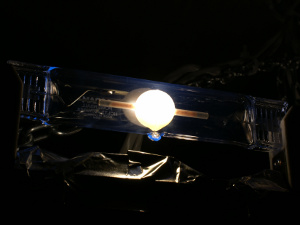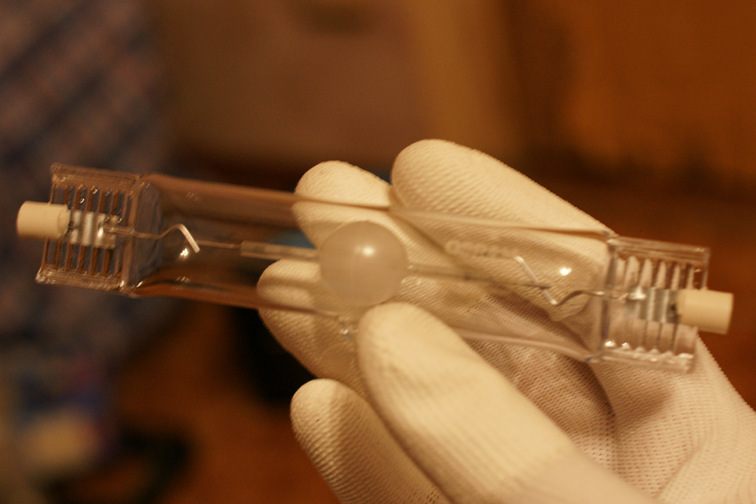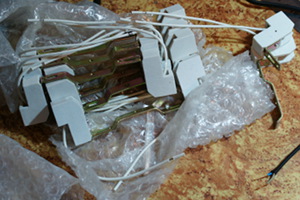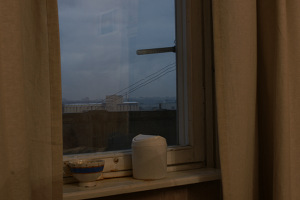100'000 lm "nuclear explosion" light fixture
 It is a general belief that IT geek should live in darkness with the only light source being computer monitor. Personally, I always liked bright light, but It was never bright enough. Initially my room was lit by 300W of incandescent lamps (4500 lm), then 250W of CFL (~15000 lm), then 500W halogen (~12500 lm)... But it all was way too weak. I always wanted light to be so bright, that you don't want to make it brighter. Now I achieved this goal and happy to share the results.
It is a general belief that IT geek should live in darkness with the only light source being computer monitor. Personally, I always liked bright light, but It was never bright enough. Initially my room was lit by 300W of incandescent lamps (4500 lm), then 250W of CFL (~15000 lm), then 500W halogen (~12500 lm)... But it all was way too weak. I always wanted light to be so bright, that you don't want to make it brighter. Now I achieved this goal and happy to share the results.Lamps
Modern trend is to use LED's for lighting - but they have a number of disadvantages: their spectra is far from sun, they are very hard to cool if you are running more than 100W of them, and finally good LED's are quite expensive. That's why I chosen to use metal halide lamps - OSRAM Powerball HCI-TS 150W/942 NDL with round ceramic arc tube - this gives spectra close to sun (including a bit of UVA light, starting at 350nm), not very expensive (around ~25$/150W), long service life (~12'000 hours) and 99 lm/W power efficiency (which is on par with the best LED's).Usually it is prohibited to use metal halide lamps without enclosed fixture due to UVB/C light and small chance of lamp explosion. These specific lamps do have filter for hard UV light (so no ozone and skin cancer
 ) and probability of explosion is greatly reduced when using electronic ballast (opposed to 'dumb' magnetic one).
) and probability of explosion is greatly reduced when using electronic ballast (opposed to 'dumb' magnetic one).
How many lamps do I need?
300W of incandescent lamps emits around 4500 lumen. 150W metal halide lamps emits around 14'200 lumen. I decided to go for a round figure - 7 lamps, which is around 1050W of power. This should yield around 14200*7 = 99400 lumen. Consumed power would be around 1050/0.9 ~1150W (including ECG efficiency) .Electronic ballasts (ECG)
One cannot directly connect metal halide lamp into 110/220V grid - they would not ignite, because ~5kV spark is required. ECG does this 5kV ignition and then provide constant current through the lamp, just like in any gas discharge lamp.Historically, first ballasts were magnetic - they were heavy, and lacked fail safe mechanisms - constantly trying to reignite damaged lamp. Modern ballasts have higher efficiency, lighter and switch off the lamp if they "feel" it's not ok.
I've bought OSRAM Powertronic PTi 150 - each lamp need it's own ECG, so 7pcs total.

Assembling
 The most complex part - is finding R7s lamp socket with right size. Wide-spread 500W halogen lamps have length 118mm and these sockets are easy to buy. Unfortunately, these metal halide lamps are longer : 138mm. So I decided to cut socket in half and add some distance between 2 parts.
The most complex part - is finding R7s lamp socket with right size. Wide-spread 500W halogen lamps have length 118mm and these sockets are easy to buy. Unfortunately, these metal halide lamps are longer : 138mm. So I decided to cut socket in half and add some distance between 2 parts.Triangle base is assembled using nuts and screws, and hanged using steel chain. ECG's are hanging on nylon cable ties. Aluminum foil is glued under each lamp in order to reduce light absorption.
Results and total cost

Light is incredible. I would call it "summer Sunday morning". Total light emission is about 99'400 lumen, which gives around 2000 lux illuminance across the room.
For comparison, 3x100W incandescent lamps gives around 4500 lumen, 3x26 compact fluorescent lamps (CFL) gives around 4680 lumen. So, I've got light which is around 20 times brighter compared to usual well-lit room.
Cost: ECG - 70$*7, lamps - 25$*8 (one spare), chain, mounts - <20$. Total ~ 710$.
With that much power electricity cost should also be taken into consideration. On maximal power whole system chews up around 1150W. With my electricity cost (~7 cents per kWh) and when working 8 hours a day this beast eats around 15-20$ worth of electricity per month.
When turned on, lamps are warming up for ~2 minutes, first 10 seconds light is really dim, and lamp color is changing significantly. If you turn off the light - ECG cannot reignite them for ~10 minutes (they need to cool down), but this is not a issue for me. There is some "buzzing" sound during startup, but nothing terrible.
Notes after 1st year of usage
All lamps survived first year. One lamp was producing a bit of ozone on turn on - and I was really concerned about that. It appeared that lamp was not set up tightly in socket, so there was a tiny spark gap.Therapeutic effect of bright light is definitely visible - there was almost no these 'gray days of depression' through the whole year. Even if it's placebo effect - I am still happy about that
 These round arc tubes looks just like the sun, and I have 7 of them :-)
These round arc tubes looks just like the sun, and I have 7 of them :-)Almost immediately I had to add aluminum reflector, so that I don't see arc itself from my work place.
I was using 7 lamps only during first month, then It started to feel a bit uncomfortable, and used to turn on only 3 lamps.
After 10 months - even 3 lamps started to feel a bit uncomfortable, so now I usually turn on only 1 lamp.
 Comparison with daylight: on full power it is definitely brighter than daylight at cloudy day. This has a downside - almost whole winter daylight was so 'dark' that I had to keep the lights on even during the day.
Comparison with daylight: on full power it is definitely brighter than daylight at cloudy day. This has a downside - almost whole winter daylight was so 'dark' that I had to keep the lights on even during the day.So, I've achieved my goal. I've built light fixture so bright, that you don't want to make it brighter. For 20 m2 room 99400 lm is probably way too bright, and 14200 lm is just ok.





 @BarsMonster
@BarsMonster